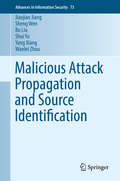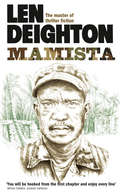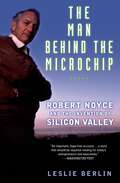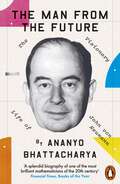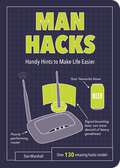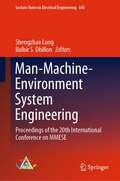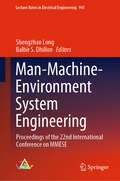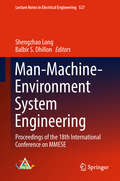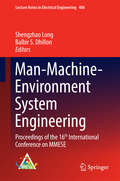- Table View
- List View
Malerfachrechnen
by Helmuth Heid Wolfgang Imhof Jürgen ReithDie vierte vollständig überarbeitete Auflage dieses Fachbuches ist so angelegt, dass es im Berufsvorbereitungsjahr, der Berufsfachschule, Berufsschule, Berufsaufbauschule und Fachoberschule ebenso eingesetzt werden kann wie in Meisterschulen, Fachschulen und in den Lehrgängen zur Vorbereitung auf die Meisterprüfung. Es entspricht den Rahmenlehrplänen der Bundesländer und den Ausbildungsrahmenlehrplänen für Maler/innen und Lackierer/innen. Die aufgeführten Kalkulationsbeispiele berücksichtigen die bevorstehende Umstellung auf den Euro, Material- und Lohnkostenwerte wurden aktualisiert, Lohn- und Gehaltsabrechnungen entsprechend erweitert, die Kostenberechnungen für Fahrzeuglackierungen auf der Basis der aktuellen Kalkulationslisten erstellt und Aufmaß- und Abzugsregeln nach gültiger VOB aufgestellt.
Malerfachrechnen
by Emil JakubowskiNach dem Tod von Herrn Jakubowski haben wir das Lehrbuch überarbeitet und auf den aktuellen Stand gebracht. Dabei wurden auch alle lohnpolitischen, steuerrechtlichen und Werkstoffpreis-Änderungen berücksichtigt. Zugleich wurde ein neuer Abschnitt aufgenommen, der in das Aufmaß mit EDV-Einsatz einführt. Wir danken den Herstellerfirmen, Großhändlern und Kollegen für Beratung, Preisanga ben und Abbildungen. Dank sagen wir dem Verlag und besonders Herrn Dr. Kalckhoff für Mithilfe und Durchsicht. Fulda, November 1990 H. Heid, W. Imhof. J. Reith Inhalt Seite 1 Grundlagen 1. 1 Grundlagen und Wiederholungen 7 1. 1. 1 Zahlen und Ziffern 7 1. 1. 2 Rechenzeichen 8 1. 2 Grundrechenarten 9 1. 2. 1 Addieren und Subtrahieren 9 1. 2. 2 Multiplizieren und Dividieren 11 1;3 Klammerrechnen 14 1. 4 Bruch rech nen 16 1. 5 Gleichungen 19 1. 6 Verhältnisrechnen 21 1. 6. 1 Proportionen 21 1. 6. 2 Goldener Schnitt 22 1. 7 Schlußrechnen 24 1. 8 Prozentrechnen 27 1. 8. 1 Rechnen mit Prozenten 27 1. 8. 2 Zinsrechnen 30 1. 8. 3 Rabatt und Skonto 32 1. 8. 4 Gewinn-und Verlustrechnen 33 1. 9 Mischungs-und Verteilungsrechnen 34 1. 10 Potenzieren und Radizieren 36 1. 11 Rechenhilfen 38 2 Längen und Flächen 2. 1 Längenberechnungen und metrisches System 41 2. 2 Maßstabrechnen 42 2. 3 Bemaßen von Zeichnungen 44 44 2. 4 Flächenberechnungen 45 2. 4. 1 Viereckige Flächen 2. 4. 2 Dreieckige Flächen 49 2. 4. 2. 1 Dreiecke 49 2. 4. 2. 2 Lehrsatz des Pythagoras 51 2.
Malicious Attack Propagation and Source Identification (Advances in Information Security #73)
by Jiaojiao Jiang Sheng Wen Bo Liu Shui Yu Yang Xiang Wanlei ZhouThis book covers and makes four major contributions: 1) analyzing and surveying the pros and cons of current approaches for identifying rumor sources on complex networks; 2) proposing a novel approach to identify rumor sources in time-varying networks; 3) developing a fast approach to identify multiple rumor sources; 4) proposing a community-based method to overcome the scalability issue in this research area. These contributions enable rumor source identification to be applied effectively in real-world networks, and eventually diminish rumor damages, which the authors rigorously illustrate in this book. In the modern world, the ubiquity of networks has made us vulnerable to various risks. For instance, viruses propagate throughout the Internet and infect millions of computers. Misinformation spreads incredibly fast in online social networks, such as Facebook and Twitter. Infectious diseases, such as SARS, H1N1 or Ebola, have spread geographically and killed hundreds of thousands people. In essence, all of these situations can be modeled as a rumor spreading through a network, where the goal is to find the source of the rumor so as to control and prevent network risks. So far, extensive work has been done to develop new approaches to effectively identify rumor sources. However, current approaches still suffer from critical weaknesses. The most serious one is the complex spatiotemporal diffusion process of rumors in time-varying networks, which is the bottleneck of current approaches. The second problem lies in the expensively computational complexity of identifying multiple rumor sources. The third important issue is the huge scale of the underlying networks, which makes it difficult to develop efficient strategies to quickly and accurately identify rumor sources. These weaknesses prevent rumor source identification from being applied in a broader range of real-world applications. This book aims to analyze and address these issues to make rumor source identification more effective and applicable in the real world. The authors propose a novel reverse dissemination strategy to narrow down the scale of suspicious sources, which dramatically promotes the efficiency of their method. The authors then develop a Maximum-likelihood estimator, which can pin point the true source from the suspects with high accuracy. For the scalability issue in rumor source identification, the authors explore sensor techniques and develop a community structure based method. Then the authors take the advantage of the linear correlation between rumor spreading time and infection distance, and develop a fast method to locate the rumor diffusion source. Theoretical analysis proves the efficiency of the proposed method, and the experiment results verify the significant advantages of the proposed method in large-scale networks. This book targets graduate and post-graduate students studying computer science and networking. Researchers and professionals working in network security, propagation models and other related topics, will also be interested in this book.
Malnutrition in the Elderly
by H. B. Stähelin W. O. SeilerH. B. Stahelin "Under-or malnutrition is a frequent and serious problem in geriatric patients" (8). Today there is no doubt that malnutrition contributes significantly to morbidity and mortality in the aged. The immune function is impaired, the risk for falls and fractures increases, in acute illness, recovery is delayed, and complications are frequent. Acute and chronic illnesses lead to a catabolic metabolism and hence increase the signs and symptoms of malnutrition. Cytokines related to inflamma tion block the synthesis of albumin and shift protein synthesis to acute phase pro teins. The activation of the ubiquitine-proteasome pathway leads to a degradation of muscle protein, which leads to an additional loss of muscle mass which occurs as age-dependent sarcopenia, and adds to the already existing frailty (2, 4). It is often difficult to decide to what extent the metabolic alterations result from malnutrition or concomitant illness. Psychological factors contribute as a circulus vitiosus significantly to anorexia and, thus, aggravate the condition. They are the most important causes of failure to thrive in old age (7). It is evident that next to the therapy of the underlying illness, an adequate support with calorie and nutrient intake over weeks becomes essen tial under these conditions. Clear-cut improvements are often only seen after 6 or more weeks. Besides a clinical, clearly visible malnutrition, selective nutrient deficits are much more frequent. Numerous and highly different mechanisms may lead to a marginal or insufficient supply with micronutrients.
Malting and Brewing Science: Volume II Hopped Wort and Beer
by J. S. Hough D. E. Briggs R. Stevens T. W. YoungSome ten years. have passed since the publication of the first edition of Malting and Brewing Science, a period of many changes. As before, this edition is an aid to teaching, particularly the MSc course in Brewing Science at Birmingham University, but it is also aimed at the requirements of other students of the science of malting and brewing throughout the world. In general, technological aspects are covered more fully in this new edition, although not malting and brewing practices that are exclusive to Britain. Nevertheless, the amount of technological information available is too great to be comprehensively covered iln one book. Scientific principles and infor mation receive more attention, but for details of analytical procedures reference should be made to the most recently published material of the Ameri can Society of Brewing Chemists, the European Brewery Convention and the Institute of Brewing. The new edition appears as two volumes because a single one would be inconveniently bulky. The first volume outlines the entire process and leads from barley, malting and water to the production of sweet wort. In the second volume there are chapters on hops and hop products, production of hopped wort, fermentation,yeast biology and all aspects of beer qualities and treatment. Decisions about the units of measurement proved difficult; metric units commonly used in the Industry are given and in parentheses are equivalents in degrees Fahrenheit, Imperial measures and UK barrels. Considerable information on equivalents is given in a special section in each volume.
Malware Analysis Using Artificial Intelligence and Deep Learning
by Mark Stamp Mamoun Alazab Andrii ShalaginovThis book is focused on the use of deep learning (DL) and artificial intelligence (AI) as tools to advance the fields of malware detection and analysis. The individual chapters of the book deal with a wide variety of state-of-the-art AI and DL techniques, which are applied to a number of challenging malware-related problems. DL and AI based approaches to malware detection and analysis are largely data driven and hence minimal expert domain knowledge of malware is needed.This book fills a gap between the emerging fields of DL/AI and malware analysis. It covers a broad range of modern and practical DL and AI techniques, including frameworks and development tools enabling the audience to innovate with cutting-edge research advancements in a multitude of malware (and closely related) use cases.
Malware Diffusion Models for Modern Complex Networks: Theory and Applications
by Vasileios Karyotis M.H.R. KhouzaniMalware Diffusion Models for Wireless Complex Networks: Theory and Applications provides a timely update on malicious software (malware), a serious concern for all types of network users, from laymen to experienced administrators. As the proliferation of portable devices, namely smartphones and tablets, and their increased capabilities, has propelled the intensity of malware spreading and increased its consequences in social life and the global economy, this book provides the theoretical aspect of malware dissemination, also presenting modeling approaches that describe the behavior and dynamics of malware diffusion in various types of wireless complex networks. Sections include a systematic introduction to malware diffusion processes in computer and communications networks, an analysis of the latest state-of-the-art malware diffusion modeling frameworks, such as queuing-based techniques, calculus of variations based techniques, and game theory based techniques, also demonstrating how the methodologies can be used for modeling in more general applications and practical scenarios.Presents a timely update on malicious software (malware), a serious concern for all types of network users, from laymen to experienced administratorsSystematically introduces malware diffusion processes, providing the relevant mathematical backgroundDiscusses malware modeling frameworks and how to apply them to complex wireless networksProvides guidelines and directions for extending the corresponding theories in other application domains, demonstrating such possibility by using application models in information dissemination scenarios
MAMista (Contemporanea Ser.)
by Len DeightonDeep in Marxist Guerilla territory a hopeless war is being fought.
Mammalian Cell Engineering: Methods and Protocols (Methods in Molecular Biology #2312)
by Ryosuke KojimaThis volume explores the latest engineering methods of mammalian cells that are useful for controlling the performance of engineered mammalian cells for future cell-based therapeutics and for better understanding of complex biological systems. The chapters in this book are organized into five parts. Part One described methods to engineer mammalian cells to sense biologically relevant inputs, such as cell contacts and soluble proteins. Part Two looks at techniques to engineer mammalian cells to sense artificial inputs, such as light and ultrasound. Part Three provides cutting-edge CRISPR-Cas-based methods to carry out highly multiplexed genome editing and spatiotemporally controlled genome editing. Part Four discusses ways to control and engineer biological events in mammalian cells in combination with chemical compounds and systems. Part Five explores techniques to engineer specific mammalian cells in targeted manners. Written in the highly successful Methods in Molecular Biology series format, chapters include introductions to their respective topics, lists of the necessary materials and reagents, step-by-step, readily reproducible laboratory protocols, and tips on troubleshooting and avoiding known pitfalls.Comprehensive and authoritative, Mammalian Cell Engineering: Methods and Protocols is a valuable resource that allows scientists to successfully carry out their research, thus ultimately contributing to the future advancement of this field.
The Mammoth Book of Combat: Reports from the Frontline (Mammoth Books)
by Jon E. LewisOver a hundred eyewitness accounts of the reality of combat from some of the finest writers of the last century and our own. Lucid, vivid, complex images of conflict, from Walt Whitman on the American Civil War to contemporary reporting from Afghanistan.The collection includes Martha Gellhorn on the Battle of the Bulge, Michael Herr at Khe Sanh, David Rohde's and Anthony Shadid's Pulitzer-winning accounts of Bosnia and Iraq respectively, Christina Lamb's famous account of being under fire from the Taliban, Robert Fisk on being attacked in Afghanistan, and Nicholas Tomalin's 'The General Goes Zapping Charlie Kong' (one of the inspirations for Apocalypse Now) among many other pieces of exceptional war reporting.
The Mammoth Book of Modern Battles (Mammoth Books)
by Jon E. LewisFrom the start of the 20th century to the most recent major offensives, here are fifty accounts of the battles that made the modern world, described in superb detail by historians and writers including John Keegan, Alan Clark, John Strawson, Charles Mey, John Pimlott, and John Laffin.All the major conflicts are covered, from two world wars, through Korea, Vietnam, Bosnia, Chechnya, to Iraq and Afghanistan. Among the battles featured are: the Somme, Passchendaele, Battle of Britain, Stalingrad, El Alamein, Monte Cassino, Omaha Beach, Iwa Jima, Dien Bien Phu, Ia Drang, Hamburger Hill, Desert Storm, Kabul, Baghdad, and Basra.
The Mammoth Book Of Special Forces Training: Physical and Mental Secrets of Elite Military Units (Mammoth Books #388)
by Jon E. LewisIn this encyclopedic book, Lewis provides insights into the origins, training, tactics, weapons and achievements of special forces and special mission units throughout the world, focusing particularly on US and UK forces. He also looks at the codes that that bind the members of these elite units together. He reveals training secrets in everything from wilderness survival to hand-to-hand combat. In doing so, he draws extensively on biographies, autobiographies, training manuals, interviews and press coverage of key operations. The elite forces covered include: The British Army’s Special Air Service (SAS), established in 1950, which has served as a model for the special forces of many countries. Its counter-terrorist wing famously took part in the hostage rescue during the siege of the Iranian Embassy in London in 1980. The Parachute Regiment, the airborne infantry element of 16 Air Assault Brigade, which spearheads the British Army’s rapid intervention capability. It is closely linked to United Kingdom Special Forces. The US Navy’s SEALS (Sea, Air, Land Teams), trained to conduct special operations in any environment, but uniquely specialised and equipped to operate from and in the sea. Together with speedboat-operating Naval Special Warfare Combatant-Craft Crewmen, they form the operational arm of the Naval Special Warfare community, the Navy component of the US Special Operations Command. Their special operations include: neutralizing enemy forces; reconnaissance; counter-terrorism (famously in the killing of Osama bin Laden); and training allies. The US Army’s Delta Force: The Special Mission Unit, 1st Special Forces Operational Detachment-Delta (1st SFOD-D), known simply as Delta Force, the Army component of Joint Special Operations Command. Its role is counter-terrorism, direct action and national intervention operations, though it has the capability to conduct many different kinds of clandestine missions, including hostage rescues and raids. The US Army Rangers, a light infantry combat formation under the US Army Special Operation Command. The Green Berets – motto: ‘to free the oppressed’ – trained in languages, culture, diplomacy, psychological warfare and disinformation. Russia’s Spetsnaz, whose crack anti-terrorist commandos ended the Moscow theatre siege, and who have a reputation for being among the world’s toughest and most ruthless soldiers. Spetsnaz units saw extensive action in Afghanistan and Chechnya, often operating far behind enemy lines. Israeli Special Forces, especially Shayetet 13 (Flotilla 13), whose motto, in common with the rest of the Israeli military, is ‘Never again’, a reference to the Holocaust. They are particularly adept at the specifically Israeli martial art Krav Maga, which they dub ‘Jew-jitsu’.
The Mammoth Book of Special Ops (Mammoth Books)
by Richard Russell LawrenceInto the eye of danger with the men who put the 'special' in special forcesThe once shadowy activities of special forces have grown into an increasingly exposed element of 21st century warfare and anti-terrorist activity. Here, in one giant unputdownable volume, are 30 of the most dangerous special operations of modern times.Drawn from the flashpoints of the world, and above all Iraq and Afghanistan, these first-hand and reported accounts of missions by the SAS, Delta Force, Green Beret, Commandos and other forces will leave you on the edge of your seat.The accounts include: Blackhawk Down - the US Delta forces debacle in Mogadishu, Somalia, 1993 British Special forces fight Al Qaeda at close quarters in Afghanistan 2003 Task Force Raider - US Special forces teams track down Saddam Hussein, 2003 The British 'Blackhawk Down' - Paras shoot their way out of trouble in Majar, Iraq 2003 The capture of insurgent leader Chemical Evil Fat Mama, Fallujah, November 2003
MAMMUT: Eine verteilte Speicherverwaltung für symbolische Manipulation (MuPad Reports)
by Holger NaundorfMan and River Systems: The Functioning of River Systems at the Basin Scale (Developments in Hydrobiology #146)
by Josselin Garnier J. M. MouchelThe volume focuses on the ecological functioning of rivers, which has received less attention than functioning of lakes and reservoirs. The selected papers cover a large range of topics relating to aquatic communities, eutrophication, nutrient dynamics and organic pollution, erosion and sediment transport, and fate of micropollutants at the basin scale. Integrated approaches developed in order to study the ecological functioning of fluvial systems perturbed by human activity are presented. This functioning is analysed from the point of view of fundamental research, but insights into system management are not neglected. This book will be of interest to researchers in the field of aquatic ecology, river system functioning, and water surface pollution, to postgraduate students, to the institutions involved in water resource management, and to the drinking water and waste water treatment industries. It draws information from many large river systems in the world.
The Man Behind the Microchip: Robert Noyce and the Invention of Silicon Valley
by Leslie BerlinHailed as the Thomas Edison and Henry Ford of Silicon Valley, Robert Noyce was a brilliant inventor, a leading entrepreneur, and a daring risk taker who piloted his own jets and skied mountains accessible only by helicopter. Now, in The Man Behind the Microchip, Leslie Berlin captures not only this colorful individual but also the vibrant interplay of technology, business, money, politics, and culture that defines Silicon Valley. Here is the life of a high-tech industry giant. The co-founder of Fairchild Semiconductor and Intel, Noyce co-invented the integrated circuit, the electronic heart of every modern computer, automobile, cellular telephone, advanced weapon, and video game. With access to never-before-seen documents, Berlin paints a fascinating portrait of Noyce: an ambitious and intensely competitive multimillionaire who exuded a "just folks" sort of charm, a Midwestern preacher's son who rejected organized religion but would counsel his employees to "go off and do something wonderful," a man who never looked back and sometimes paid a price for it. In addition, this vivid narrative sheds light on Noyce's friends and associates, including some of the best-known managers, venture capitalists, and creative minds in Silicon Valley. Berlin draws upon interviews with dozens of key players in modern American business--including Andy Grove, Steve Jobs, Gordon Moore, and Warren Buffett; their recollections of Noyce give readers a privileged, first-hand look inside the dynamic world of high-tech entrepreneurship. A modern American success story, The Man Behind the Microchip illuminates the triumphs and setbacks of one of the most important inventors and entrepreneurs of our time.
The Man Behind the Microchip: Robert Noyce and the Invention of Silicon Valley
by Leslie BerlinHailed as the Thomas Edison and Henry Ford of Silicon Valley, Robert Noyce was a brilliant inventor, a leading entrepreneur, and a daring risk taker who piloted his own jets and skied mountains accessible only by helicopter. Now, in The Man Behind the Microchip, Leslie Berlin captures not only this colorful individual but also the vibrant interplay of technology, business, money, politics, and culture that defines Silicon Valley. Here is the life of a high-tech industry giant. The co-founder of Fairchild Semiconductor and Intel, Noyce co-invented the integrated circuit, the electronic heart of every modern computer, automobile, cellular telephone, advanced weapon, and video game. With access to never-before-seen documents, Berlin paints a fascinating portrait of Noyce: an ambitious and intensely competitive multimillionaire who exuded a "just folks" sort of charm, a Midwestern preacher's son who rejected organized religion but would counsel his employees to "go off and do something wonderful," a man who never looked back and sometimes paid a price for it. In addition, this vivid narrative sheds light on Noyce's friends and associates, including some of the best-known managers, venture capitalists, and creative minds in Silicon Valley. Berlin draws upon interviews with dozens of key players in modern American business--including Andy Grove, Steve Jobs, Gordon Moore, and Warren Buffett; their recollections of Noyce give readers a privileged, first-hand look inside the dynamic world of high-tech entrepreneurship. A modern American success story, The Man Behind the Microchip illuminates the triumphs and setbacks of one of the most important inventors and entrepreneurs of our time.
The Man from the Future: The Visionary Life of John von Neumann
by Ananyo Bhattacharya'A sparkling book, with an intoxicating mix of pen-portraits and grand historical narrative. Above all it fizzes with a dizzying mix of deliciously vital ideas. . . A staggering achievement' Tim HarfordAn exhilarating new biography of John von Neumann: the lost genius who invented our worldThe smartphones in our pockets and computers like brains. The vagaries of game theory and evolutionary biology. Self-replicating moon bases and nuclear weapons. All bear the fingerprints of one remarkable man: John von Neumann.Born in Budapest at the turn of the century, von Neumann is one of the most influential scientists to have ever lived. His colleagues believed he had the fastest brain on the planet - bar none. He was instrumental in the Manhattan Project and helped formulate the bedrock of Cold War geopolitics and modern economic theory. He created the first ever programmable digital computer. He prophesied the potential of nanotechnology and, from his deathbed, expounded on the limits of brains and computers - and how they might be overcome.Taking us on an astonishing journey, Ananyo Bhattacharya explores how a combination of genius and unique historical circumstance allowed a single man to sweep through so many different fields of science, sparking revolutions wherever he went.Insightful and illuminating, The Man from the Future is a thrilling intellectual biography of the visionary thinker who shaped our century.
Man Hacks: Handy Hints to Make Life Easier (Life Hacks Ser.)
by Dan MarshallMAN HACKS is the ultimate guide to making essential guy stuff easier. This fully illustrated manual covers everything from culinary cheats, DIY secrets and tidying-up shortcuts to style tips and party tricks – everything you need to keep your man credentials fully in check.
Man-Machine Dialogue: Design and Challenges
by Frederic LandraginThis book summarizes the main problems posed by the design of a man–machine dialogue system and offers ideas on how to continue along the path towards efficient, realistic and fluid communication between humans and machines. A culmination of ten years of research, it is based on the author’s development, investigation and experimentation covering a multitude of fields, including artificial intelligence, automated language processing, man–machine interfaces and notably multimodal or multimedia interfaces. Contents Part 1. Historical and Methodological Landmarks 1. An Assessment of the Evolution of Research and Systems. 2. Man–Machine Dialogue Fields. 3. The Development Stages of a Dialogue System. 4. Reusable System Architectures. Part 2. Inputs Processing 5. Semantic Analyses and Representations. 6. Reference Resolution. 7. Dialogue Acts Recognition. Part 3. System Behavior and Evaluation 8. A Few Dialogue Strategies. 9. Multimodal Output Management. 10. Multimodal Dialogue System Assessment. About the Authors Frédéric Landragin is a computer science engineer and has a PhD from the University of Lorraine, France. He is currently in charge of linguistics research for the French National Center for Scientific Research (CNRS). His studies focus on the analysis and modeling of language interpretation. Man–machine dialogue is one of the applications of this research.
Man-Machine Dialogue: Design and Challenges
by Frederic LandraginThis book summarizes the main problems posed by the design of a man–machine dialogue system and offers ideas on how to continue along the path towards efficient, realistic and fluid communication between humans and machines. A culmination of ten years of research, it is based on the author’s development, investigation and experimentation covering a multitude of fields, including artificial intelligence, automated language processing, man–machine interfaces and notably multimodal or multimedia interfaces. Contents Part 1. Historical and Methodological Landmarks 1. An Assessment of the Evolution of Research and Systems. 2. Man–Machine Dialogue Fields. 3. The Development Stages of a Dialogue System. 4. Reusable System Architectures. Part 2. Inputs Processing 5. Semantic Analyses and Representations. 6. Reference Resolution. 7. Dialogue Acts Recognition. Part 3. System Behavior and Evaluation 8. A Few Dialogue Strategies. 9. Multimodal Output Management. 10. Multimodal Dialogue System Assessment. About the Authors Frédéric Landragin is a computer science engineer and has a PhD from the University of Lorraine, France. He is currently in charge of linguistics research for the French National Center for Scientific Research (CNRS). His studies focus on the analysis and modeling of language interpretation. Man–machine dialogue is one of the applications of this research.
Man-Machine-Environment System Engineering: Proceedings of the 20th International Conference on MMESE (Lecture Notes in Electrical Engineering #645)
by Balbir S. Dhillon Shengzhao LongThis book presents selected papers introducing readers to the key research topics and latest development trends in the theory and application of MMESE. The advanced integrated research topic man-machine-environment system engineering (MMESE) was first established in China by Professor Shengzhao Long in 1981, with direct support from one of the greatest modern Chinese scientists, Xuesen Qian. In a letter to Shengzhao Long from October 22nd, 1993, Xuesen Qian wrote: “You have created a very important modern science and technology in China!”MMESE primarily focuses on the relationship between man, machine and environment, studying the optimum combination of man-machine-environment systems, where “man” refers to people in the workplace (e.g., operators, decision-makers), “machine” is the general name for any object controlled by man (including tools, machinery, computers, systems and technologies), and “environment” describes the specific working conditions under which man and machine interact (e.g., temperature, noise, vibration and hazardous gases). The three goals of optimizing such systems are ensuring safety, efficiency and economy.Presenting interdisciplinary studies on the concepts and methods in physiology, psychology, system engineering, computer science, environmental science, management, education and other related disciplines, this book is a valuable resource for all researchers and professionals whose work involves MMESE subjects.
Man-Machine-Environment System Engineering: Proceedings of the 22nd International Conference on MMESE (Lecture Notes in Electrical Engineering #941)
by Balbir S. Dhillon Shengzhao LongMan-Machine-Environment System Engineering: Proceedings of the 22nd Conference on MMESE are an academic showcase of the best papers selected from more than 500 submissions, introducing readers to the top research topics and the latest developmental trends in the theory and application of MMESE. This proceedings are interdisciplinary studies on the concepts and methods of physiology, psychology, system engineering, computer science, environment science, management, education, and other related disciplines. Researchers and professionals who study an interdisciplinary subject crossing above disciplines or researchers on MMESE subject will be mainly benefited from this proceedingsMMESE primarily focuses on the relationship between Man, Machine and Environment, studying the optimum combination of man-machine-environment systems. In this system, “Man” refers to working people as the subject in the workplace (e.g. operators, decision-makers); “Machine” is the general name for any object controlled by Man (including tools, machinery, computers, systems and technologies), and “Environment” describes the specific working conditions under which Man and Machine interact (e.g. temperature, noise, vibration, hazardous gases etc.). The three goals of optimization of the man-machine-environment systems are to ensure safety, efficiency and economy. The integrated and advanced science research topic Man-Machine-Environment System Engineering (MMESE) was first established in China by Professor Shengzhao Long in 1981, with direct support from one of the greatest modern Chinese scientists, Xuesen Qian. In a letter to Shengzhao Long from October 22nd, 1993, Xuesen Qian wrote: “You have created a very important modern science and technology in China!”
Man-Machine-Environment System Engineering: Proceedings of the 18th International Conference on MMESE (Lecture Notes in Electrical Engineering #527)
by Shengzhao Long Balbir S. DhillonThese proceedings showcase the best papers selected from more than 500 submissions, and introduce readers to the hottest research topics and the latest developmental trends in the theory and application of MMESE. The integrated and advanced science research topic Man-Machine-Environment System Engineering (MMESE) was first established in China by Professor Shengzhao Long in 1981, with direct support from one of the greatest modern Chinese scientists, Xuesen Qian. In a letter to Long from October 22nd, 1993, Qian wrote: “You have created a very important modern science and technology in China!” MMESE primarily focuses on the relationship between Man, Machine and Environment, studying the optimum combination of man-machine-environment systems. In this system, “Man” refers to working people as the subject in the workplace (e.g. operators, decision-makers); “Machine” is the general name for any object controlled by Man (including tools, machinery, computers, systems and technologies), and “Environment” describes the specific working conditions under which Man and Machine interact (e.g. temperature, noise, vibration, hazardous gases etc.). The three main goals of optimizing man-machine-environment systems are to ensure safety, efficiency and economy. These proceedings present interdisciplinary studies on essential concepts and methods from physiology, psychology, system engineering, computer science, environmental science, management, education, and other related disciplines. As such, they offer a valuable resource for all researchers and professionals whose work involves interdisciplinary areas touching on MMESE subjects.
Man-Machine-Environment System Engineering: Proceedings of the 16th International Conference on MMESE (Lecture Notes in Electrical Engineering #406)
by Shengzhao Long Balbir S. DhillonThis research topic was first established in China by Professor Shengzhao Long in 1981, with direct support from one of the greatest modern Chinese scientists, Xuesen Qian. In a letter to Shengzhao Long from October 22nd, 1993, Xuesen Qian wrote: “You have created a very important modern science subject and technology in China!”MMESE primarily focuses on the relationship between Man, Machine and Environment, studying the optimum combination of man-machine-environment systems. In this system, “Man” refers to working people as the subject in the workplace (e.g. operators, decision-makers); “Machine” is the general name for any object controlled by Man (including tools, machinery, computers, systems and technologies), and “Environment” describes the specific working conditions under which Man and Machine interact (e.g. temperature, noise, vibration, hazardous gases etc.). The three goals of optimization are to ensure "Safety, High efficiency and Economy" of man-machine-environment systems.These proceedings are an academic showcase of the best papers selected from more than 400 submissions, introducing readers to the top research topics and the latest developmental trends in the theory and application of MMESE.These proceedings are interdisciplinary studies on the concepts and methods of physiology, psychology, system engineering, computer science, environment science, management, education, and other related disciplines. Researchers and professionals who study an interdisciplinary subject crossing above disciplines or researchers on MMESE subject will be mainly benefited from these proceedings.


